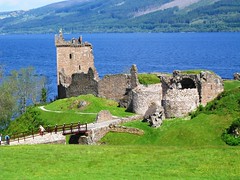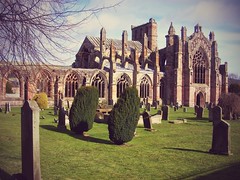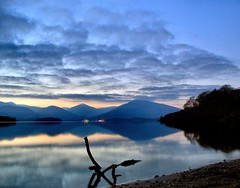Scottish Mountain Timeline
Scottish Mountain Chronology
1590 First possible documented ascent of a Scottish 'mountain'. There are two documented early ascents of mountains that are now listed as Munros. The first of these took place about 1590, when 'Mad' Colin Campbell of Glenlyon made the ascent of Stuch an Lochain (960m, OS Sheet 51, M194, peak of the little loch). This peak lies far up Glen Lyon, above Castle Meggernie, built by 'Mad' Campbell.
1618 Ascent of Mount Keene by John Taylor, The 'Water Poet' of London.(He was a waterman on the Thames, hence his pen-name.) This pamphleteer, from London, passed over this mountain on his way from Glenmark to Braemar, in July or August, 1618. In his amusing description of the walk he verified the wetting ability of 'Scottish Miste', as well as commenting on the temperature difference between valley and top.
1774
Schiehallion use to 'weigh' the Earth. The Astronomer Royal, the Rev. Nevil Maskelyne (so unflatteringly portrayed in the recent television adaptation of 'Longitude'), spends four months on Schiehallion making observations relating to the density of the earth.
1769 Ascent of Ben More. Ben More, Crianlarich, was climbed in 1769 by a group of astronomers, seeking to observe a transit of the planet Venus.
1771 Early Ascents of Ben Nevis. In 1771, the first recorded ascent of Ben Nevis was made, by the botanist James Robertson, then collecting specimens. He was followed three years later by John Williams, who was on the lookout for commercial mineral deposits. In 1787, a third recorded ascent was made by a Lieutenant Walker and party. This ascent seems to have had no other purpose other than curiosity, and what is interesting is that it seems likely that in the three years between these two latter ascents, many had made the laborious climb to the summit for pleasure, as some 30 small cairns were found by Walker on the summit plateau.
1791 Ordnance Survey founded. Following the second ill-fated Jacobite rebellion in 1745, Cumberland's Deputy Quartermaster General, Lieutenant-General Watson, decided that a map of the Highlands was required. An infantry detachment, under the direction of William Roy, was posted to Fort Augustus in 1747,where they spent the next eight years on this mammoth task. It was largely due to him that the Ordnance Survey was founded in 1791. The principal project for the next 33 years was the production of a one-inch to the mile map of Great Britain. In 1810, their triangulations reached Scotland. The Director-General, from 1820 to 1846 was Thomas Colby.
1850 Highland Estate Building. A period during which the scenery and romantic stories of and about the Highlands of Scotland led to a rapid expansion of travelling and sport. In order to facilitate this, many houses and estates were built. The tracks built for stalking are often still in use today and can be useful for hill approaches. This period of 'Balmoralism' (named after Queen Victoria's Highland Castle) was made easier by the 'clearances', when crofters were displaced to make way for more profitable sheep.
1856 Hugh Thomas Munro born in London. Munro born in London, at 27 Eaton Place. The eldest of a family of nine. His collecting habit starts early, with butterflies, birds' eggs, shells, fossils and so on. Goes to school in Crieff, Perthshire.
1873 Munro in Germany. Munro goes to Stuttgart to learn German. Starts climbing in the Alps.
1875 Munro returns to London. Back in London, Munro studies business methods and enjoys the social life. He has a good ear for music and becomes an expert dancer. Goes to Europe as Aide-de-Camp to General the Honourable W. Fielding. Several years later develops pleurisy.
1877 Large scale (six-inch) field survey of Scotland completed by O.S. The O.S. complete the six-inch maps, the basis for the one-inch series to follow.
1880 Munro in S. Africa. To improve his health, Munro goes to S. Africa, as Private Secretary to Sir George Colley, Governor of Natal. When the Basuto War breaks out volunteers for active service and carries despatches as a member of an irregular cavalry corps, Landrey's Horse. At end of war returns home to London, bringing with him Basuto and Zulu curios, antelope heads, a black boy, and a monkey.
1880 Railway reaches Tyndrum. The Oban Railway Line reaches Tyndrum, making it easier to reach many mountainous areas.
1883 O.S. one-inch maps cover most of Scotland. Growth of walking clubs. In the 3rd quarter of this century, at least a dozen walking and rambling clubs were formed in the Lowlands of Scotland.
1884 Early listing of Scottish Mountains. Third Edition of 'The Highland Sportsman and Tourist' (Robert Hall) - Lists 236 heights of 3000ft or more. But it is not known for certain whether Munro saw this, or other early lists.
1885 Munro tries politics. Munro, now living mainly at the family home in Forfarshire, at Lindertis, stands as Conservative candidate for Kirkcaldy Burghs. And gets heavily defeated. Continues to explore the Scottish hills.
1889 Formation of Scottish Mountaineering Club. March 1889, Glasgow. The SMC is constituted after correspondence in the 'Glasgow Herald' discussing the possibility of forming a 'Scottish Alpine Club'. There was already in Scotland a small nucleus of active and experienced mountaineers, but contact between them was spare. The SMC begin a Journal in 1890, initially published three times a year, and including a serially published guide to the Scottish Mountains. The first Editor, J.G. Stott, commissions Munro to draw up a list of Scottish mountains. Munro has to date climbed 42 tops.
1891 Munro's Tables Published The famous tables are published for the first time in September, 1891, in the sixth issue of Volume 1 of the SMC Journal. They include 538 tops which exceed 3,000 feet in height; 283 are deemed to be separate mountains. Munro completed the list in five months of very hard work, using many field notes collected before and during its compilation. In a note to the Tables, Munro admits that he did not foresee the amount of work which would be required. Munro is 35.
1892 Marries general's daughter. Travels widely. He continues, while in Scotland, to work on the Tables, as he is not completely happy with the first edition.
1892 Munro becomes 3rd President of SMC. As President he entertains his fellow members on Club Meets by playing the flute. He does not drink tea.
1901 Rev. A.E. Robertson completes Munros to become 1st Munroist. The Reverend Archibald Eneas Robertson, 4th President of the SMC, completed the Munros on September 1901, with an ascent of Meall Dearg on the Aonach Eagach ridge, Glen Coe. Having a parish in Rannoch, and with long holidays, he realised that the target was not impossible. In 1898, for example, a three months' holiday allowed 75 additions. In 1899 another 72 were added. He may not have climbed the Inaccessible Pinnacle on Skye (technically, it was on the list as a top, an anomaly which Munro no doubt would have corrected in a future edition). He may also have not climbed Ben Wyvis, but he is recognised as a pioneering walker in a time before properly constructed roads or railways. He died at the age of 88, in 1958.
1914 First World War. Munro goes to Malta. During the winter of 1915-16, being past military age, Munro worked in Malta, helping to trace the missing for the Red Cross. He catches some sort of malarial fever, and returns home for a while.
1918 Munro and two daughters in France. Munro goes out to France with his two daughters, organising a canteen for troops at Tarascon, Provence.
1919 Munro dies in France. Munro catches influenza and dies of pneumonia at Tarascon, in his small hotel room on March 19th. He is aged 63. There is a funeral service at which the locals pays homage to his charitable work. Brought back to Scotland he is buried beside his mother and wife, next to family home, near Kirriemuir. This is on 2nd April. He had still to climb two of the Munros; Carn an Fhidhleir (Feshie), and Carn Cloich-mhuilinn. (The Inaccessible Pinnacle was down on his list as a top, and not a Munro.)
1921 2nd Edition of The Tables Two years after Munro's death, the SMC, under the guidance of the 'Master of the Rolls', James Gall Inglis, publish the second edition of the Tables. Based on Munro's Card Index, and his annotated personal copy, there were many changes to the original; including the spelling of hill names, improvements in locations and heights and so on. 40-odd tops changed status, being either promoted to Munros, demoted to Tops, or deleted!
1923 Rev. A.R.G. Burn completes Munros to become 2nd Munroist. The Reverend Burn completes the Munros, including the Innaccessible Pinnacle and the tops, to become 2nd Munroist, finishing on July 20th, 1923. This double completion, of both the Munros and tops, was accomplished only six times before the early 1950s. Burn died in 1973, well into his 80s, having worked as a Latin and Greek proof-reader for the Oxford University Press, for 29 years. Some would consider Burns the first true Munroist.
1929 J.A. Parker becomes 3rd Munroist. James Parker climbs the Munros in 1929, adding in the Furths. (The 3000'ers of England, Wales & Ireland.) He thought he had done them in 1927, but on returning from a trip round the world he found that a new Munro had been discovered (Beinn Tarsuinn).
1930 John Rooke Corbett completes as No. 4. Corbett finishes both the Munros and, like Burn, the tops as well. He also climbs all of Scotland's 2,000-foot hills, which become known henceforth as the Corbetts.
1933 First completion without a beard. J. Dow becomes the 5th Munroist, and the first to complete without the 'semi-illegitimate assistance of a beard.' Dow climbed 214 out of the 277 Munros with the help of a motor car, 'somebody else's when available, or my own in the last resort.' Dow later completed the tops and the Furths.
1933 Tables re-published. Munros Tables were re-published, with few amendments.
1938 First completion by a non-SMC member. J. Robertson becomes the 6th to complete, and the first who is not a member of the SMC.
1947 First female Munroist. Mrs J. Hirst completes with her husband, to become the first female Munroist. No.10.
1953 New Edition of Munro's Tables. Tables re-published, with few amendments.
1957 The first Clerk of the List. Eric Maxwell is No. 30, and also becomes the first multiple completer in 1966. He is later the first 'Keeper of the Gate', or 'Clerk of the List' as the position is now known, organizing and recording the list of completers. By 1960, with better transport and equipment, the list was about to start a meteoric growth.
1962 The 50th Munroist. A Miss L. Ticehurst completes in 1962 to become No. 50, some 61 years after the Rev. A.E. Robertson.
1967 First attempt at a continuous round. The brothers Brian & Alan Ripley make an attempt to complete all the Munros in one continuous walk. They begin in August and are forced by bad weather and swelling ankles to give up in mid-November.
1969 Tables re-published. Munros Tables re-published, with minor changes.
1970 The 100th Munroist. SMC member Mike Geddes becomes Munroist 100.
1971 Sandy's Big Walk Sandy Cousins makes a solo walk from North to South, from Ben Hope to Ben Lomond. In 26 days he averages 22.5km and 1070m of ascent per day, taking in 103 tops and 47 Munros.
1974 First Metric List, First continuous round. First Metric Edition of Munro's Tables published by the SMC. The classic 3,000 feet becomes 914.4 metres. James Donaldson edited the first metric Tables, and although few metric heights were in fact available, he converted Imperial heights to metric. Often the heights were in fact based on contours only. Beinn Tarsuinn and two other Letterewe Munros were introduced (Ruadh Stac Mor and Beinn a'Chlaidheimh), while poor wee Beinn an Lochain was deleted. These changes were due to new heights from the O.S. Six-figure grid references also introduced. Hamish Brown completes a round in one continuous trip lasting 112 days. At the end of this year, there were a recorded 130 Munroists, averaging about five per year. Brown had done three complete rounds before his continuous walk, and went on to complete another three following it! He took 18 months to prepare for the walk. For the statistically curious, Brown's 'vital statistics' regarding his walk are as follows: Mileage: 1,639 (2,640km) Footage: 449,000 (137,000m) Time: 112 days Daily average: 4,000 feet (1,220m), 14' miles (23.3km). Brown climbed all of the 279 Munros as the list was then, with five climbed a second time. Five Corbetts were also climbed, making a grand total of some 289 peaks. One interesting figure produced by Brown, and also backed up by the walks done by Ripley, Hinde, and Cousins, is that on average you take 1,500 feet (457m) and four miles (6.44km) per Munro.
1978 'Hamish's Mountain Walk' published. First published by Victor Gollancz, London (1978). Now available as a reprint by Baton Wicks, along with 'Climbing the Corbetts.'
1981 New Edition of Munro's Tables. Munroist No. 250. James Donaldson and Hamish Brown jointly edit a new edition of the Tables. New metric maps almost completed, and accuracy of positions and heights improved. Garbh Chioch Mhor, Mullach an Rathain and Sgurr Fiona promoted, Carn Cloich-mhuilinn and six other easterly Munros demoted. Leonard Moss recorded as No. 250.
1982 A number is set by for The Unknown Munroist. The number 284 is given over to 'THE UNKNOWN MUNROIST.' There is a full explanation of this in the 1983 SMC Journal (p.389), but as many will find this difficult to access the brief story is that this number, the same as the then total number of Munros (and therefore until recently 276!), is assigned to those who 'are deliberate non-reporters, others who refuse to compleat their final Munro and still others, equally obtuse but more metaphysical, who claim that they don't know that they have already compleated..' In others words, number 284 is allocated to all those dissidents. For other reasons, the count at one point might well have ceased at 665; instead it is left unfilled. (See Revelation, xiii,18.)
1984 Tables re-published. Tables re-published, with minor amendments. Beinn Teallach promoted.
1985 'The Munros' published by the SMC.'High Mountains' by Irvine Butterfield published.
1987 Munroist No. 500. Graham S. Wilson is No. 500 on the List.
1989 First Member of Parliament Chris Smith completed the Munros in 1989
1990 Tables re-published. Munroist No. 750. Munros Tables re-published with Derek Bearhop as new Editor. David A. Henderson is No. 750 on the List, as numbers continue to rocket.
1991 1000 Munroists recorded. Angus K. Robertson recorded as Munroist No. 1000 (although completing in 1989).
1993 Munroist No. 1250. Gordon Hopper hits the 1250 slot.
1997 New Edition of Munro's Tables. Includes eight new Munros. Munroist No. 1750 and 8 New Munros Bearhop grasps the nettle and introduces eight new Munros. Winds of change moves through SMC committee as Bearhop given the go-ahead for clean-up of Tables. Mark Aiken is No. 1750 on the charts.
1995 Munroist No. 1500. A. Smith rounds off a millennium and a half at No. 1500. Dave Purser completes a round in reverse order of height.
1998 Munroist No. 2000 ' the Big One! Rati Chiba is awarded the prize number, with 2000. Richard Wood of Cannich, with 6,278 ascents of various Munros, has probably done more Munro ascents than anyone else on the planet. The SMC publish The Munros on CD-ROM.
1999 Record Multiple Completer Stewart Logan climbed Schiehallion on December 31st to complete his 10th round of the Munros. He accomplishes this as a charitable event. Number of compleaters recorded in SMC Journal reaches 2066.
2000 David F. Brown becomes compleatist number 2,500; the deluge continues.
2001 The Centenary of the Rev. A.E. Robertson's compleation; the SMC plan a celebratory dinner
















